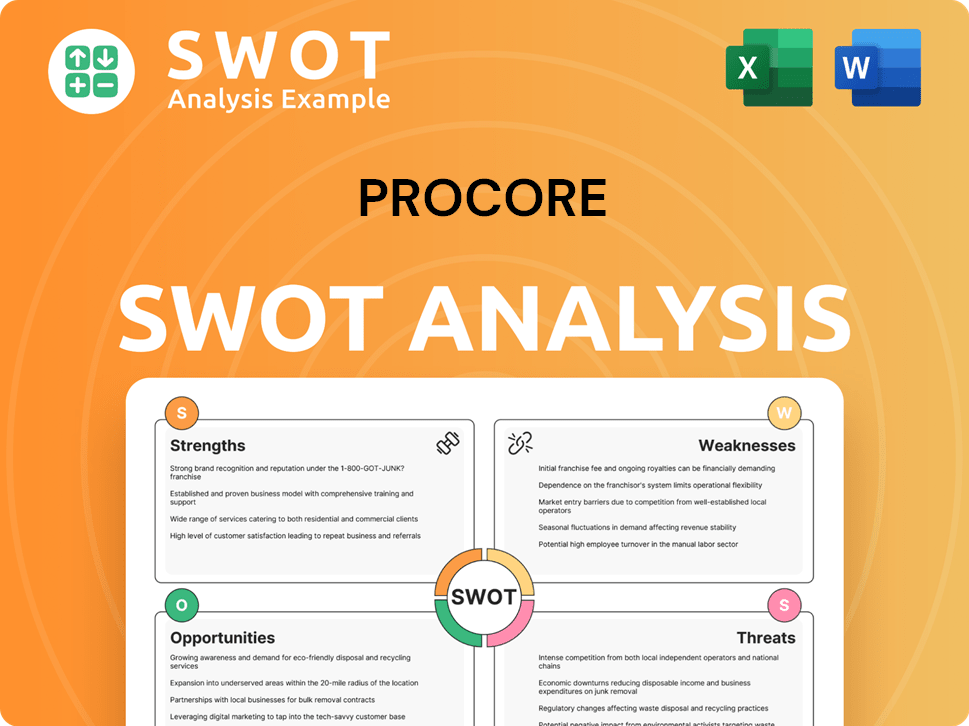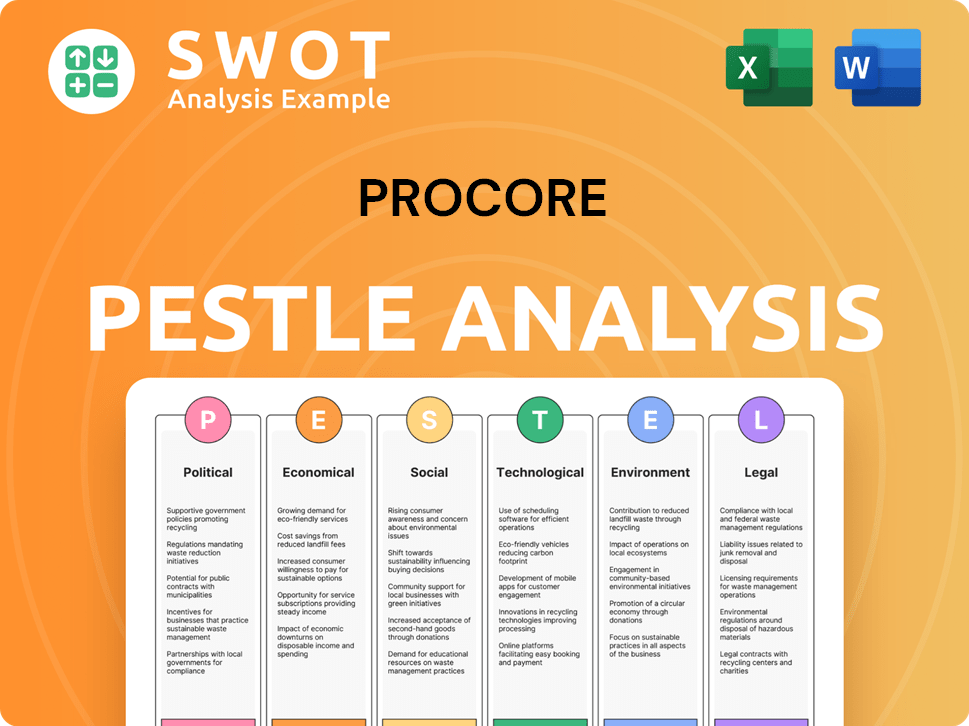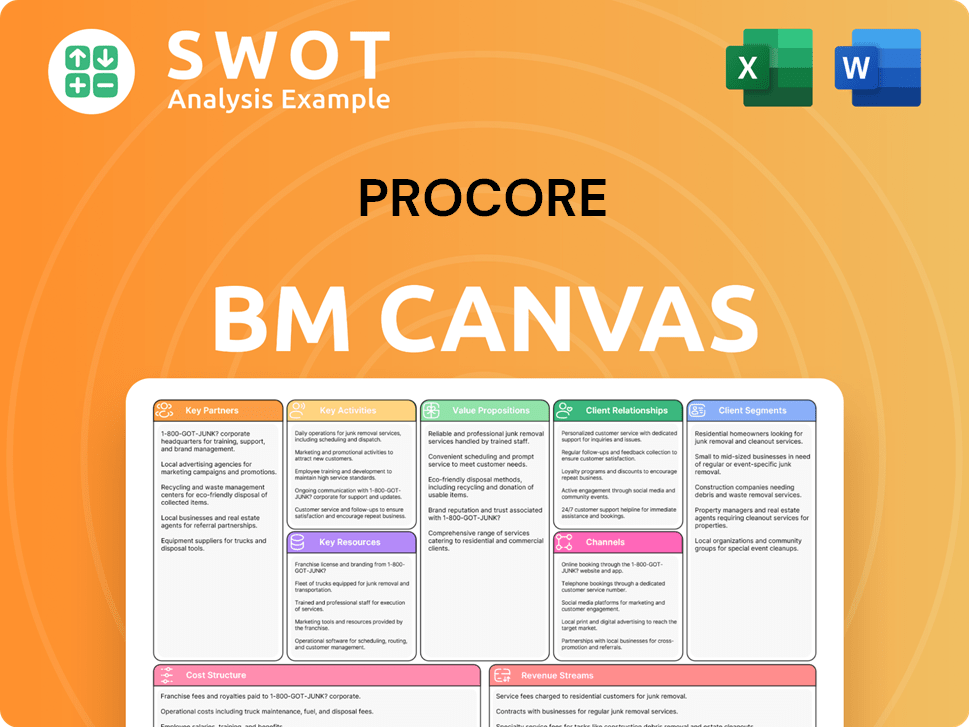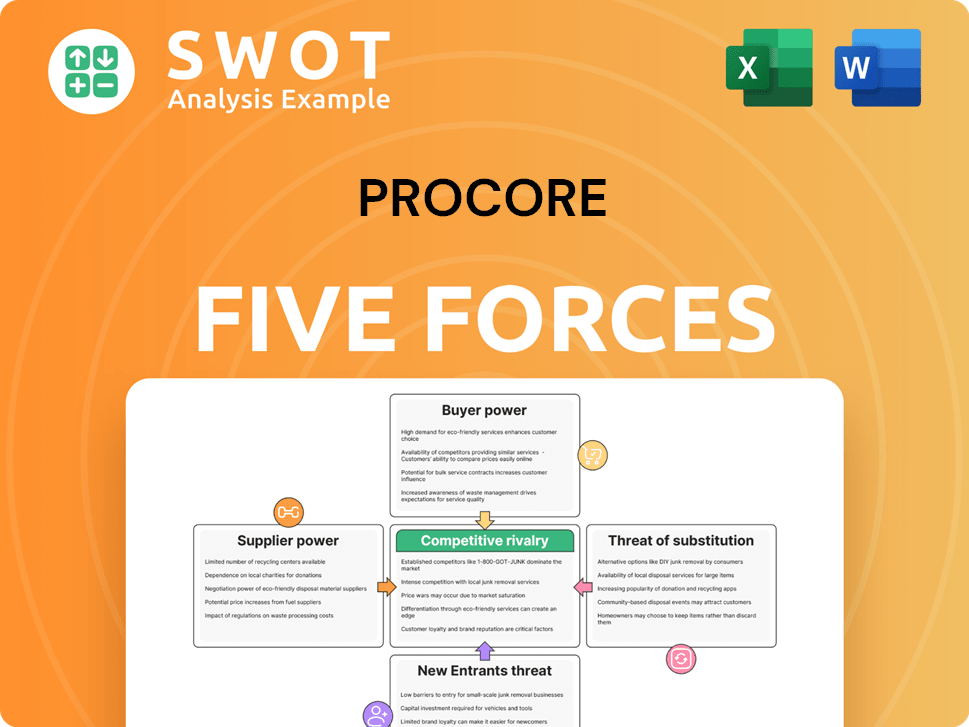Procore Bundle
Who Does Procore Serve in the Construction Realm?
The construction industry's digital evolution has created a need to understand customer demographics and target markets for companies like Procore. Procore Technologies, Inc. emerged to streamline complex construction projects through cloud-based software. The company's growth from a startup to a major public entity, with revenues reaching $1.152 billion in 2024, highlights its successful adaptation to market needs.

This exploration delves into Procore's Procore SWOT Analysis, examining its customer base, geographical distribution, and strategic approaches. Understanding the Procore target market and Procore user profile is crucial for grasping its market position. Analyzing Customer demographics Procore provides insights into the evolving landscape of construction software users and construction management software adoption.
Who Are Procore’s Main Customers?
Understanding the customer demographics of the construction software market is crucial for businesses like Procore. Procore's primary customer segments are businesses (B2B) within the construction industry. These include general contractors, subcontractors, project managers, architects, engineers, and owners who utilize the platform for various project management aspects.
The Procore target market is specifically focused on professionals and organizations involved in construction. The goal is to increase efficiency and reduce risk throughout the construction project lifecycle, from preconstruction to closeout. While detailed demographic breakdowns by age, gender, or income level for individual users are not publicly available, the focus is on the professional roles and types of construction firms.
Procore's customer base includes a diverse range of construction professionals, with general contractors and subcontractors forming significant segments. These users rely on Procore for managing budgets, schedules, communication, and specialized services.
Procore's user profile includes a broad spectrum of construction professionals. These include general contractors, subcontractors, project managers, architects, engineers, and owners. The platform caters to various project management needs, from preconstruction to closeout.
Procore has seen substantial growth in its high-value customer segments. In 2024, customers contributing over $100,000 in annual recurring revenue (ARR) increased by 16% year-over-year. The number of customers contributing over $1,000,000 in ARR rose by 39%.
Procore is focusing on securing larger enterprise clients and expanding their platform usage. This is driven by a 'Go-To-Market' (GTM) transition towards a specialist-driven sales model. The total number of organic customers reached 17,306 by March 31, 2025.
Larger customers represented 63% of total ARR in 2024, highlighting their growing importance. By the end of 2024, the total number of organic customers reached 17,088. Net new organic customers added in Q4 2024 were 113.
Procore's strategic focus is on expanding its enterprise client base and increasing platform usage. The growth in high-value customers indicates the success of this strategy. The company's Growth Strategy of Procore is centered on providing comprehensive solutions for the construction industry.
- By December 31, 2024, 2,333 organic customers contributed over $100,000 in ARR, a 16% increase year-over-year.
- Customers contributing over $1,000,000 in ARR increased by 39% to 86 in 2024.
- The total number of organic customers reached 17,088 by the end of 2024.
- By March 31, 2025, the total number of customers increased to 17,306, with 2,418 customers contributing over $100,000 of ARR, reflecting a 14% year-over-year growth rate.
Procore SWOT Analysis
- Complete SWOT Breakdown
- Fully Customizable
- Editable in Excel & Word
- Professional Formatting
- Investor-Ready Format

What Do Procore’s Customers Want?
Understanding the customer needs and preferences is crucial for any business, and for companies like Procore, this means focusing on the construction industry. Procore's customers, including a wide range of construction professionals, are driven by the need for increased efficiency, reduced risk, and streamlined collaboration across complex projects. The demand for digital transformation and the rising costs within the industry further emphasize these needs, making solutions like Procore's essential.
The Procore user profile is characterized by a desire for real-time visibility, advanced analytics, and ease of use. These features are critical for making informed decisions and improving productivity. The platform aims to eliminate the operational inefficiencies and information silos often found when using multiple point solutions or manual processes. By offering integrated project management, financial management, and resource management tools, Procore provides a comprehensive solution to these challenges.
Procore's ability to meet these needs is reflected in its product development and customer satisfaction. The company actively incorporates customer feedback and market trends, continuously improving its platform. For example, the integration with FYLD, an AI-powered field work effectiveness platform, has led to productivity gains of up to 12% and a reduction in safety risks by over 48%. Procore's commitment to delivering measurable return on investment (ROI) is a key factor in retaining a loyal customer base.
Procore's customers prioritize solutions that enhance efficiency, reduce risks, and improve collaboration. This includes a unified platform that connects all project stakeholders and automates workflows. The need for digital transformation and the rising costs in the construction industry drive the demand for Procore's offerings, making it a vital tool for construction software users.
- Efficiency: Customers seek tools to streamline workflows and reduce manual processes.
- Risk Reduction: The platform aims to minimize potential risks through better data management and real-time insights.
- Collaboration: Procore facilitates seamless communication and data sharing among all project stakeholders.
- Real-time Visibility: Customers require access to up-to-date project information for better decision-making.
- Advanced Analytics: The platform provides data-driven insights to improve productivity and project outcomes.
Procore PESTLE Analysis
- Covers All 6 PESTLE Categories
- No Research Needed – Save Hours of Work
- Built by Experts, Trusted by Consultants
- Instant Download, Ready to Use
- 100% Editable, Fully Customizable

Where does Procore operate?
The geographical market presence of the company is global, with its headquarters in Carpinteria, California, U.S., and offices spanning across several international locations. These include Sydney, Toronto, London, Dublin, and Dubai. This widespread presence supports multiple languages and currencies, showcasing a localized approach to cater to diverse markets. The company's strategy is to offer comprehensive construction management software solutions worldwide.
While the United States remains the primary market for the company, its international expansion presents a significant growth opportunity. The company's construction software users and construction management software are seeing increased adoption globally. The company's focus on international markets is a key aspect of its customer acquisition strategy.
Non-U.S. revenue accounted for 15% of total revenue for the three months ended March 31, 2025, an increase from 14% for the same period in 2024. The company's international revenue grew by 18% year-over-year in Q1 2025, and on a constant currency basis, it grew by 20% year-over-year. The company’s penetration of the international total addressable market is currently less than 2% by value, highlighting substantial room for expansion.
The company is actively localizing its approach by decentralizing sales efforts. It adapts to local market needs through a new general manager go-to-market model. This strategy aims to better address the unique requirements of different regions in the highly localized construction industry.
Recent expansions include the acquisition of Novorender AS in January 2025. This 3D viewer and building information modeling platform enhances capabilities for large-scale construction projects. This acquisition further solidifies its global offerings and supports its target market for Procore project management.
The company is exploring opportunities in emerging markets for construction technology adoption. This includes areas such as India, Southeast Asia, and the Middle East. These regions project significant infrastructure investments, making them key areas for expansion.
The company's global footprint is supported by offices in various international locations. This helps serve a diverse customer base. The company's international presence is a key factor in its overall market strategy, as highlighted in the Marketing Strategy of Procore.
Procore Business Model Canvas
- Complete 9-Block Business Model Canvas
- Effortlessly Communicate Your Business Strategy
- Investor-Ready BMC Format
- 100% Editable and Customizable
- Clear and Structured Layout

How Does Procore Win & Keep Customers?
The company utilizes a multi-faceted strategy for attracting and retaining customers, focusing on both broad market reach and targeted engagement. This approach includes leveraging digital platforms and demonstrating the measurable return on investment (ROI) of its software to construction professionals. The company capitalizes on its position as a cloud-based construction management software provider, appealing to an industry increasingly embracing digital transformation. This positions the company well within the Procore target market.
Sales tactics are evolving to a specialist-driven sales model, focusing on specific customer segments and product offerings. This restructuring aims to secure larger, more strategic deals and drive enterprise expansion. This consultative sales approach is expected to increase customer lifetime value (LTV) through cross-selling and retention. The ability to secure multiple seven-figure Annual Recurring Revenue (ARR) contracts demonstrates the success of this strategic shift. Understanding the Procore user profile is key to this sales strategy.
Customer retention is a significant strength, with a gross revenue retention rate of 94% for 2024 and 95% in Q1 2025. The net revenue retention rate was 106% for 2024, indicating successful expansion within existing customer accounts. The high retention rates are a testament to the company's focus on customer satisfaction and value delivery. The company's approach to customer acquisition and retention is data-driven, using customer data and segmentation to tailor solutions.
The company heavily invests in digital platforms to reach construction software users. They prioritize demonstrating the ROI of their software to construction professionals. This helps in acquiring and retaining customers by showcasing the value and efficiency of the platform.
The company is transitioning to a specialist-driven sales model. This involves restructuring the sales organization to focus on specific customer segments. This model aims to secure larger deals and drive enterprise expansion, increasing customer lifetime value.
The company fosters customer loyalty through an 'unlimited user and support model.' This allows all project participants access to the platform and the same level of support at no additional cost. This approach enhances user satisfaction and retention.
The company provides helpful forums, support chat, and dedicated customer success teams. They also offer a library of updated articles, videos, free training webinars, and continuing education courses. These initiatives improve customer satisfaction and retention rates.
The company's strategy includes a strong emphasis on digital marketing to reach the Procore clients. Additionally, the company focuses on a specialist-driven sales model, customer success initiatives, and product innovation to drive growth. These strategies are vital for both acquiring new customers and retaining existing ones.
- Digital Marketing and ROI Focus: Emphasizing the value of the software.
- Specialist-Driven Sales: Targeting specific customer segments.
- Unlimited User and Support Model: Enhancing customer loyalty.
- Customer Success Initiatives: Providing resources and support.
- Product Innovation: Driving cross-selling and deepening relationships.
Procore Porter's Five Forces Analysis
- Covers All 5 Competitive Forces in Detail
- Structured for Consultants, Students, and Founders
- 100% Editable in Microsoft Word & Excel
- Instant Digital Download – Use Immediately
- Compatible with Mac & PC – Fully Unlocked

Related Blogs
- What are Mission Vision & Core Values of Procore Company?
- What is Competitive Landscape of Procore Company?
- What is Growth Strategy and Future Prospects of Procore Company?
- How Does Procore Company Work?
- What is Sales and Marketing Strategy of Procore Company?
- What is Brief History of Procore Company?
- Who Owns Procore Company?
Disclaimer
All information, articles, and product details provided on this website are for general informational and educational purposes only. We do not claim any ownership over, nor do we intend to infringe upon, any trademarks, copyrights, logos, brand names, or other intellectual property mentioned or depicted on this site. Such intellectual property remains the property of its respective owners, and any references here are made solely for identification or informational purposes, without implying any affiliation, endorsement, or partnership.
We make no representations or warranties, express or implied, regarding the accuracy, completeness, or suitability of any content or products presented. Nothing on this website should be construed as legal, tax, investment, financial, medical, or other professional advice. In addition, no part of this site—including articles or product references—constitutes a solicitation, recommendation, endorsement, advertisement, or offer to buy or sell any securities, franchises, or other financial instruments, particularly in jurisdictions where such activity would be unlawful.
All content is of a general nature and may not address the specific circumstances of any individual or entity. It is not a substitute for professional advice or services. Any actions you take based on the information provided here are strictly at your own risk. You accept full responsibility for any decisions or outcomes arising from your use of this website and agree to release us from any liability in connection with your use of, or reliance upon, the content or products found herein.